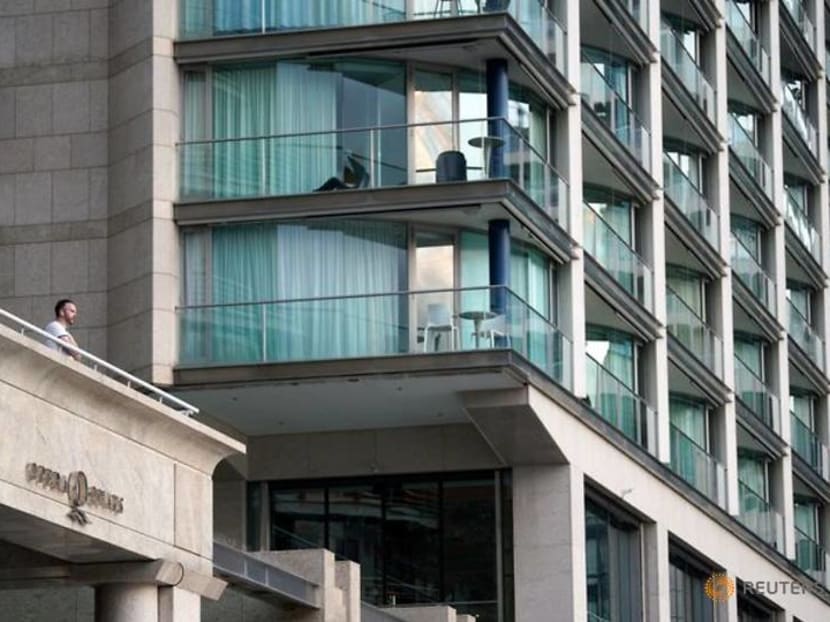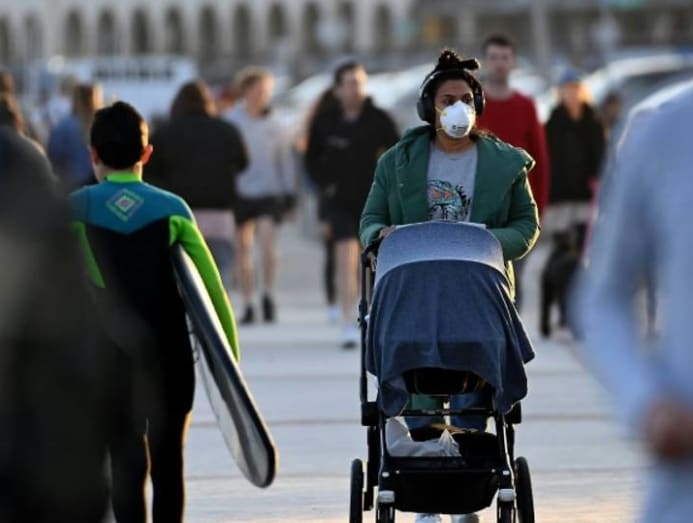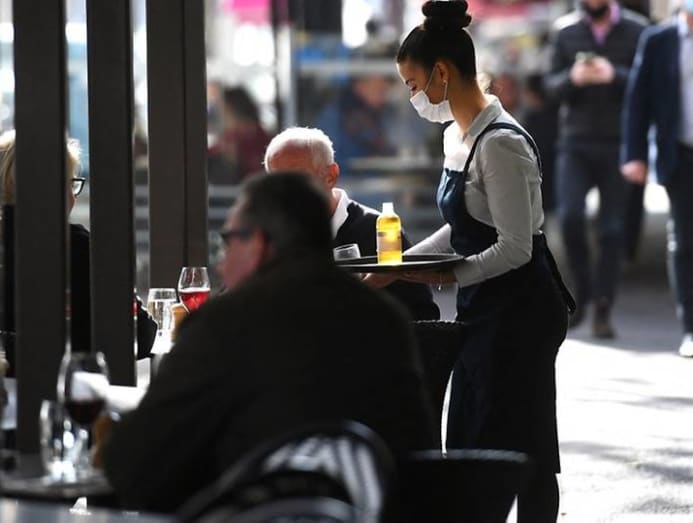Commentary: Australia’s high-rise apartment block lockdowns could have been avoided
With low vaccination rates and slow restrictions when outbreaks occur, it’s little wonder why apartment blocks can be lightning rods in Australia, says Mike Yeo.

A man looks on from a balcony of an apartment building near the Sydney Opera House. (Photo: Reuters)
MELBOURNE: Amid Australia’s on-and-off cycle of citywide lockdowns is a curious feature: The ringfencing of individual apartment complexes on occasion when clusters occur.
The latest involves a 29-unit apartment tower in the Sydney suburb of Bondi, locked down since Jul 13 after nine residents across five apartments tested positive. Police have been stationed outside to enforce the quarantine.
In another part of the country, a block of 78 apartments in Melbourne’s inner western suburb of Maribyrnong saw similar restrictions slapped on the same day, after workers connected to the Sydney apartment moved furniture there. A 14-day quarantine was imposed after two residents tested positive.
And just this week, a third high-rise with 23 units in the inner suburb of Richmond joined the two on Saturday (Jul 17) after a resident was deemed a close contact of an existing case and tested positive.

THE STRESS OF STAYING IN SMALL SPACES
These lockdowns have induced distress among residents. Being cooped up in a tiny apartment typically 60 to 80 sq metres in size during winter without being able to leave even for exercise or grocery shopping comes at a high price.
Residents are also upset with the short notice, with some claiming they were caught unaware despite letterbox drops or text messages informing them hours before their apartment buildings were closed off to the outside world.
But the New South Wales and Victorian health departments defended the decision, with both noting the communal areas of apartment towers, which in Australia tend to be enclosed with little or no access to fresh air, pose an increased transmission risk of the Delta variant.
READ: Commentary: Unvaccinated teenagers risk turning schools into viral COVID-19 reservoirs
Still, this Australian approach has drawn criticism, particularly during the no-notice lockdown of nine public housing towers in Melbourne at the start of the city’s devastating second wave of COVID-19 cases last July.
At its peak, the 2020 apartment tower lockdowns confined some 3,000 residents to mostly dimly and poorly ventilated homes, judging from the small windows visible from the outside.
That episode was marked by complaints of spotty, even non-delivery of food, medicines and other essentials, promised by the state government. It jeopardised the livelihoods of residents unable to work, because their jobs involved manual labour, while children could not attend school.
READ: Commentary: Inaccurate public understanding of COVID-19 vaccine efficacy has implications for vaccination rates
The restrictions also threw inequality into the spotlight. Residents of the towers in North Melbourne and the inner western suburbs of Flemington, housed less well-off, mainly non-English-speaking migrant families. Residents, some of whom came from war zones and were already distrusting of authorities, felt singled out.
Officials too have pointed out how such restrictions veered on being discriminatory, where the restrictions may have been made on the basis of the socio-economic status and ethnicity of the residents.
Victorian ombudsman Deborah Glass hit out at the restrictions in December 2020, asserting that the state government had wrongly assumed the towers were “a hotbed of criminality and non-compliance and that the people could not be trusted, if warning was given, not to escape the lockdown”.
(Are COVID-19 vaccines still effective against new variants? And could these increase the risk of reinfection? Experts explain why COVID-19 could become a “chronic problem" on CNA's Heart of the Matter podcast.)
SUPPRESSING THE VIRUS
The New South Wales state government has come under criticism for being averse and slow to introduce broader measures to stem the Sydney outbreak, resulting in the need for harsher, more onerous measures like high-rise lockdowns that disproportionately affect a small group of people later on – measures that are futile in averting spread to the community.
The latest uptick in cases started in mid-June when an unvaccinated limousine driver ferrying flight crew from the Sydney airport tested positive.
The Delta variant of the virus then rapidly swept through the city, taking hold in the relatively well-off eastern suburbs before seeping into the working-class western suburbs in early July. Daily caseloads reached 100 new infections by the middle of the month.
READ: Commentary: We have to live with an endemic COVID-19. Here's what that could look like
New South Wales Premier Gladys Berejiklian had initially opted for softer measures such as allowing retail outlets to keep operating and letting businesses and workers decide if they were “essential” instead of ordering them to close.
Mandatory mask-wearing has only been introduced this week, while density limits at venues like restaurants, nightspots and sports stadiums have been quite rapidly relaxed and led to clusters springing up among crowds attending Australian Rules football and rugby games in Melbourne.
With New South Wales’ infection numbers continuing to spike, and the state government only tightening bans on browsing in shops, social gatherings indoors and limits on outdoor gatherings on Jul 9, Australians feel such restrictions should have been imposed earlier.
After all, other Australian territories acted faster, with most restricting or banning travellers from Sydney and the state of New South Wales from entering when Sydney cases rose in late-June.
READ: Commentary: How did Melbourne become the centre of the ‘world’s strictest lockdown’?

They have also been quicker to introduce lockdowns when positive cases from Sydney were detected in their communities, with Brisbane, Darwin, Perth, Townsville and even the outback town of Alice Springs locking down for short periods in the past month.
THE QUESTION OF VACCINATION
The continuing outbreaks have left Australia’s coronavirus elimination strategy in tatters, despite some of the strictest curbs in the world on travel in a bid to keep out COVID-19. This strategy has left some 35,000 Australian citizens worldwide in the queue to get home, many waiting since March 2020.
Vaccination could hold the key to a sustainable reopening of the Australia economy without undue risks. Experts have identified stepping up vaccination rates as the only way for the island to break out of this maddening cycle of lockdowns.
And yet only over 10 per cent of Australia’s 25 million population have been fully vaccinated, the lowest among OECD nations, meaning even small outbreaks in major cities will continue to result in snap lockdowns and leave businesses reeling.
READ: Commentary: South Koreans wring hands over removing mask rules for the vaccinated
Indeed, Australian Prime Minister Scott Morrison had previously said on several occasions that the programme was “not a race” when asked about his government acquiring a relatively small number of Pfizer’s mRNA vaccine back in 2020 and relying on AstraZeneca’s vaccine manufactured onshore.
But supply of vaccines aside, poor attitudes over vaccination are also at the heart of Australia’s low vaccination rate. A recent Australian Bureau of Statistics survey shows only 73 per cent of respondents were willing to get vaccinated. More than a quarter of the population would potentially remain unvaccinated, assuming all Australians who want a vaccine can get jabbed immediately.
Some operate under the delusion that life is back to normal due to low infection and death numbers. A survey of voters by Australia’s Resolve Strategic found more than half of Australians surveyed do not want the current restrictions continued as more are vaccinated. Many are understandably tired from the constant cycle of lockdowns.
These probably explain why Australians continue to hold parties and gatherings over the past year despite numbers ticking up. The most well-known is a Western Sydney birthday party that spawned 24 infections from 30 attendees. Six vaccinated partygoers escaped unscathed, underlining the importance of getting vaccinated.
A POST-COVID NORMAL STILL FAR AWAY FROM AUSTRALIA
Prime Minister Morrison’s roadmap out of the pandemic in early July has been attacked by critics for lacking critical details such as target vaccination rates and dates for achieving these milestones, making it more an aspirational statement than an actionable strategic plan for now.
This, when coupled with what has so far been a very risk-averse strategy of trying to eliminate the virus, could mean that without drastic changes in mindset, navigating its way out of the pandemic for Australia is near-impossible.
It may be at least mid-2022 or later before things can return to a semblance of normality down under.
To be sure, Australia’s suite of measures to deal with future outbreaks will almost certainly continue to include high-rise lockdowns – a convenient tool to show state governments are doing something when the alternative is to impose unpopular restrictions on a broader segment of the population.
All those Australian residents who still have half of their quarantine to go and everyone else who might experience an apartment complex lockdown in the future should know this all could be prevented.
Mike Yeo writes from Melbourne. He is the Asia reporter for US-based defence publication Defense News.





